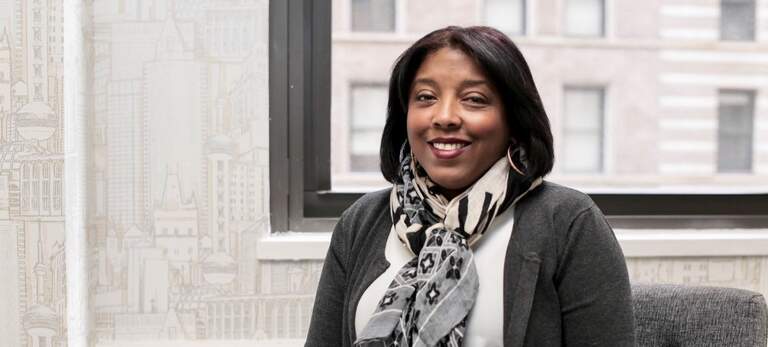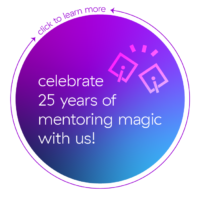Following our recent Q&A exploring the challenges that Black students face in college, we take a look at the difficulties of ensuring true equity in our schools and workplaces. As we celebrate Black History Month, iMentor’s Chief Talent & Equity Officer Kelli Doss discusses what diversity, equity, and inclusion should look like on college campuses and how organizations can build a more diverse pipeline of leaders.
Kelli has a track record of serving youth, communities, and urban education systems in Minneapolis, Washington, D.C., and New York City. Before joining iMentor in 2013, Kelli served as vice president, human assets at Education Pioneers, developing key organizational strategies on internal talent recruitment, diversity and inclusion, and organizational culture building. She spent more than a decade with organizations including New Leaders for New Schools, the NYC Department of Education, the Harlem Community Justice Center, the National Black Child Institute, and the Children’s Defense Fund. She received her undergraduate degree from Howard University and her J.D. from Tulane Law School.
You attended Howard University, a historically Black college. What was that experience like, and how did that affect your outlook on education?
Kelli: I grew up in Louisiana and my parents wanted to make sure I had the best education I could get. I went to a private Catholic school where my brother and I were the first students of color to walk the halls. It was quite an experience for me, a six-year-old going into first grade. I was the only one for many years, and by the time I went to high school, I was still just one of maybe five students of color.
I knew I wanted to go to one of the historically Black colleges and universities, and I chose Howard because my dad was a graduate. Howard changed my life—a whole new world opened up for me. I found my voice. I found a community. I understood the importance of being able to walk into a classroom and see a professor who looked like me.
Seeing other Black and brown faces on a campus and knowing that we shared a bond but that we were very much individuals—it reinforced for me the importance of having your community, whether at work or school.
You’ve worked on educational equity from several different vantage points over your career. What kind of progress have we made when it comes to higher education serving students of color?
Kelli: There's progress and yet, after all this time, I would hope that the conversation would be a little bit different. I'm still talking about some of the same things from when I took my first education-related job. Students of color still aren't getting what they need from our schools, and there is still a lot of language of low expectations. So much resides in racial trauma for Black and brown kids in this country. And I don't know that we know how to address that or are willing to address that. We think that if we recruit enough students of color, then we've addressed diversity. But we haven't addressed equity and inclusion.
Let's talk about that. What does equity and inclusion look like for colleges? How can colleges be more welcoming to students of color?
Kelli: We need more colleges and universities thinking about how to hire and retain faculty of color and administrators of color. The first time a student of color hits campus, it makes a world of difference to see someone who looks like them in a position of power. Someone who thinks about how students of color may not be as prepared to go to college—some of the very things that we're trying to work on here at iMentor. Colleges can step up with summer transition programs to help students of color not just be academically successful but also socially comfortable in the academic world.
Also, how do we work with white students to make sure that we're building on their understanding of diversity and their cultural competency, and having conversations with white students early and often about things like white privilege, fragility, and how to be an ally? We devote resources to supporting our students of color, but there's definitely some work on the other side if you want to create a culture that's welcome.
We have more students of color graduating with advanced degrees, MBAs, law degrees and so forth. But it's still an uphill battle in the workplace, especially when you're talking about leadership at the upper levels. What could organizations do better to build a more diverse pipeline of leaders?
Kelli: That's a question that I think about all day, every day. It's similar to what I said about colleges and universities, and it applies even more so to organizations. Organizations often think in terms of a numbers game, right? “As long as we hire more talent that looks like our underrepresented populations, then we're doing the work.” But it's so surface. It should go much deeper than that.
It's not just about hiring people. It's about retaining and developing people. Organizations have to, first off, really understand this and make it a solid commitment. There's this huge gap between good intentions and measurable action. What does it take to get that measurable action? And I don't want this to sound like the iMentor commercial, but every year we have our Meta Mentor Program, which is an internal mentoring program for newer or more junior staff. This year we decided that we wanted a huge part of that group to focus on men of color. Because when we look at our numbers, men of color are not being retained or developed the same way.
Another thing that organizations have to do is not just assume that they understand the experience of their staff of color on the ground, but make sure that they're getting that info, whether through a survey or through one-on-one interviews. It makes a world of difference for a person to feel like they're being heard. You have to create structures in order for that to happen. We need to check our own biases as managers and as leaders. How do you start addressing biases and white supremacy culture practices? How do you figure out how they are creating barriers for people of color and for organizational growth? How do we hold managers more accountable for the development of their staff of color? How do we create more internal opportunities for staff of color? All of those are huge pieces.
One of our values at iMentor is human potential. And doing these things puts human potential into action. I do know some organizations that are trying to do this. It feels like right now everybody is actively working on this, but we're all at different stages in our process.
Learn about iMentor’s mission, values, and commitment to diversity.

